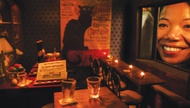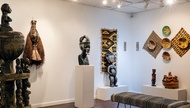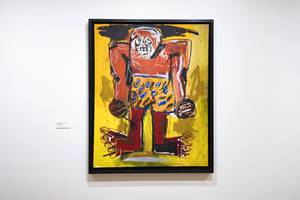“I can best describe myself as a Neo-Expressionist painter, [but] philosophically, I am human.” So reads the Facebook bio of painter Biscuit Street Preacher (born Robby Martin, though everyone just calls him Biscuit), whose “ferocious urban paintings”—enormous, vibrant and kinetic interpretations of city life that seem to grow and change even as you consider them—could only be the product of a searching human imagination, one under the influence of the most colorful city in the world.
You can see two of Biscuit’s paintings displayed at the newly-renovated BLVD & Main Taphouse at the Strat—one that actually bends around a corner, the other an epic 64 feet long. Recently, Biscuit took a moment to talk about what inspired those works, and the scenes yet to come.
Let’s talk influences. Well, back in the day it was Basquiat; that’s pretty obvious in my earlier work. But these days there’s two local artists that really have been influencing me, because of their sheer passion and their ideals and dreaming big. Sush Machida—I love how big he goes. And the other is Aaron Sheppard. I like what he’s doing right now; he’s really just exploring himself, finding the root of his art.
How big of a role has Las Vegas played in the evolution of your style? Gigantic. It’s a city for dreamers, you know. Anything you can dream up is possible here. That idea was concreted when [my wife Mary and I] moved to Washington and Idaho for a while. You know, nice people, great little towns … but not a lot of big dreams, not a lot of gigantic aspirations. We ran back to Las Vegas because I like being around big dreamers, and my goodness, there’s no city like this on Earth. It’s one of the most colorful places you can find, but it has influences from the deepest, darkest depths of mankind; some of the most beautiful things you will ever see. I attribute a lot of my creative identity and artwork to Las Vegas. I’m grateful to be here.
Where do you go in town to get inspired? I’m in love with Main Street right now. Between Main Street and the Arts District, it’s finally happening. I like just walking up and down Main Street these days especially at night, with the lights hanging across the street; you get a whole different feel.
Do you listen to music while you’re working? Absolutely. I like Gogol Bordello when I’m in kind of a gypsy mood. I’m really into Silversun Pickups, Twenty One Pilots, Arctic Monkeys, Black Rebel Motorcycle Club …
You know, my studio is the center of our house. We don’t have a living room, just a big art room. Mary and I spend a lot of time in that room listening to music, with our cocktails and our art. It’s an everyday thing.
How long do you work on each painting? A painting can take anywhere from a couple of weeks to a month, depending its size and complexity and how inspired I am with it. Just like anything in life, there are some things that you get more excited about and other things that are not quite as moving. It’s like a great book that you can’t put it down. Paintings are like that, too. There are times where you start one and you’re like, ‘Wow.’ You’re super excited about it.’ You get up in the middle of the night; you just have to paint it. Those ones go really quick. Other ones take a little more time.
What does the local arts scene need that it doesn’t have? I think Las Vegas is right on track. Like I said, I’m very excited about the Arts District and how it has grown. … Before, I shipped a lot of my paintings to Los Angeles, and I still do. But I’m getting more and more attention here.







